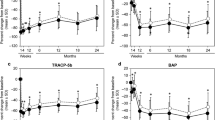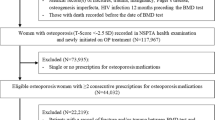Abstract
Summary
A first intravenous dose of bisphosphonates may be associated with an acute-phase response (APR). In bisphosphonate-naïve women with postmenopausal osteoporosis, the characteristics and frequency of APR may differ by compound. Prior bisphosphonate exposure was predictive of APR risk and severity.
Introduction
Intravenous (IV) administration of bisphosphonates (BP), such as zoledronate (ZOL) and ibandronate (IBN), may be associated with an APR. The characteristics of APR may differ by compound. The aim of the present study was to evaluate the characteristics of APR (rates, signs and symptoms, severity), in the absence of any preventive measure, after a first IV application of ZOL or IBN in patients naïve or previously exposed to BP in a real-world clinical setting.
Methods
This is an open-label prospective exploratory study with two cohorts of consecutive postmenopausal women with osteoporosis treated with either IV ZOL or IBN at the Department of Osteoporosis of the University Hospital of Berne, Switzerland.
Results
Intravenous BP was administered to 725 women (411 ZOL and 314 IBN). Prior oral or IV BP use was less frequent in the ZOL group (61.8 vs. 71.7%, p = 0.005). In total, 301 women (41.5%) reported the presence of one or more signs or symptoms of APR with rates for ZOL and IBN of 47.7 and 33.4%, respectively (p < 0.001). Corresponding APR rates in the subgroup of BP-naïve patients were 55.6 and 32.4%, respectively (p < 0.001). The leading APR clinical sign was the presence of post-dose myalgia or arthralgia (68.1%). Prior BP exposure was predictive of both APR risk and severity, and lower serum 25-hydroxy vitamin D (25(OH)D) levels were possibly predictive of severity.
Conclusions
In a real-world setting, APR rates with ZOL and IBN may be higher than reported in randomised controlled trials and may differ by compound, prior BP exposure, and serum 25(OH)D levels.

Similar content being viewed by others
References
Kanis JA, McCloskey EV, Johansson H, Cooper C, Rizzoli R, Reginster JY, Scientific Advisory Board of the European Society for C, Economic Aspects of O, Osteoarthritis, the Committee of Scientific Advisors of the International Osteoporosis F (2013) European guidance for the diagnosis and management of osteoporosis in postmenopausal women. Osteoporos Int : J Est Result Coop Between Eur Found Osteoporos Natl Osteoporos Foundat USA 24:23–57
Cosman F, de Beur SJ, LeBoff MS, Lewiecki EM, Tanner B, Randall S, Lindsay R, National Osteoporosis F (2014) Clinician’s guide to prevention and treatment of osteoporosis. Osteoporos Int : J Est Result Coop Between Eur Found Osteoporos Natl Osteoporos Foundat USA 25:2359–2381
Fleisch H (1987) Bisphosphonates—history and experimental basis. Bone 8(Suppl 1):S23–S28
Jung A, Bisaz S, Fleisch H (1973) The binding of pyrophosphate and two diphosphonates by hydroxyapatite crystals. Calcif Tissue Res 11:269–280
Russell RG, Rogers MJ, Frith JC, Luckman SP, Coxon FP, Benford HL, Croucher PI, Shipman C, Fleisch HA (1999) The pharmacology of bisphosphonates and new insights into their mechanisms of action. J Bone Miner Res Off J Am Soc Bone Miner Res 14(Suppl 2):53–65
Amin D, Cornell SA, Gustafson SK, Needle SJ, Ullrich JW, Bilder GE, Perrone MH (1992) Bisphosphonates used for the treatment of bone disorders inhibit squalene synthase and cholesterol biosynthesis. J Lipid Res 33:1657–1663
Roelofs AJ, Jauhiainen M, Monkkonen H, Rogers MJ, Monkkonen J, Thompson K (2009) Peripheral blood monocytes are responsible for gammadelta T cell activation induced by zoledronic acid through accumulation of IPP/DMAPP. Br J Haematol 144:245–250
Thompson K, Rogers MJ (2004) Statins prevent bisphosphonate-induced gamma,delta-T-cell proliferation and activation in vitro. J Bone Miner Res Off J Am Soc Bone Miner Res 19:278–288
Adami S, Bhalla AK, Dorizzi R, Montesanti F, Rosini S, Salvagno G, Lo Cascio V (1987) The acute-phase response after bisphosphonate administration. Calcif Tissue Int 41:326–331
Delmas PD, Adami S, Strugala C et al (2006) Intravenous ibandronate injections in postmenopausal women with osteoporosis: one-year results from the dosing intravenous administration study. Arthritis Rheum 54:1838–1846
Black DM, Delmas PD, Eastell R et al (2007) Once-yearly zoledronic acid for treatment of postmenopausal osteoporosis. N Engl J Med 356:1809–1822
Reid IR, Gamble GD, Mesenbrink P, Lakatos P, Black DM (2010) Characterization of and risk factors for the acute-phase response after zoledronic acid. J Clin Endocrinol Metab 95:4380–4387
Sieber P, Lardelli P, Kraenzlin CA, Kraenzlin ME, Meier C (2013) Intravenous bisphosphonates for postmenopausal osteoporosis: safety profiles of zoledronic acid and ibandronate in clinical practice. Clin Drug Investig 33:117–122
(1993) Consensus development conference: diagnosis, prophylaxis, and treatment of osteoporosis. Am J Med 94:646–650
(1994) Assessment of fracture risk and its application to screening for postmenopausal osteoporosis. Report of a WHO study group. World Health Organ Tech Rep Ser 843:1–129
Looker AC, Orwoll ES, Johnston CC Jr, Lindsay RL, Wahner HW, Dunn WL, Calvo MS, Harris TB, Heyse SP (1997) Prevalence of low femoral bone density in older U.S. adults from NHANES III. J Bone Miner Res Off J Am Soc Bone Miner Res 12:1761–1768
Looker AC, Wahner HW, Dunn WL, Calvo MS, Harris TB, Heyse SP, Johnston CC Jr, Lindsay R (1998) Updated data on proximal femur bone mineral levels of US adults. Osteoporos Int :J Est Result Coop Between Eur Found Osteoporos Natl Osteoporos Found USA 8:468–489
Schousboe JT, Shepherd JA, Bilezikian JP, Baim S (2013) Executive summary of the 2013 International Society for Clinical Densitometry Position Development Conference on bone densitometry. J Clin Densitom : Off J Int Soc Clin Densitom 16:455–466
Hans D, Downs RW Jr, Duboeuf F, Greenspan S, Jankowski LG, Kiebzak GM, Petak SM (2006) Skeletal sites for osteoporosis diagnosis: the 2005 ISCD Official Positions. J Clin Densitom : Off J Int Soc Clin Densitom 9:15–21
Popp AW, Senn C, Franta O, Krieg MA, Perrelet R, Lippuner K (2009) Tibial or hip BMD predict clinical fracture risk equally well: results from a prospective study in 700 elderly Swiss women. Osteoporos Int :J Est Result Coop Between Eur Found Osteoporos Natl Osteoporos Found USA 20:1393–1399
Lyles KW, Colon-Emeric CS, Magaziner JS et al (2007) Zoledronic acid in reducing clinical fracture and mortality after hip fracture. N Engl J Med 357 nihpa40967
Bertoldo F, Pancheri S, Zenari S, Boldini S, Giovanazzi B, Zanatta M, Valenti MT, Dalle Carbonare L, Lo Cascio V (2010) Serum 25-hydroxyvitamin D levels modulate the acute-phase response associated with the first nitrogen-containing bisphosphonate infusion. J Bone Miner Res Off J Am Soc Bone Miner Res 25:447–454
Wark JD, Bensen W, Recknor C, Ryabitseva O, Chiodo J 3rd, Mesenbrink P, de Villiers TJ (2012) Treatment with acetaminophen/paracetamol or ibuprofen alleviates post-dose symptoms related to intravenous infusion with zoledronic acid 5 mg. Osteoporos Int :J Est Result Coop Between Eur Found Osteoporos Natl Osteoporos Found USA 23:503–512
Silverman SL, Kriegman A, Goncalves J, Kianifard F, Carlson T, Leary E (2011) Effect of acetaminophen and fluvastatin on post-dose symptoms following infusion of zoledronic acid. Osteoporos Int :J Est Result Coop Between Eur Found Osteoporos Natl Osteoporos Found USA 22:2337–2345
Acknowledgements
We are grateful to Philippe Kress, MD, for reviewing and commenting on our manuscript.
Author information
Authors and Affiliations
Corresponding author
Ethics declarations
Conflicts of interest
Kurt Lippuner is the primary investigator in clinical development programs in the field of metabolic bone diseases from Amgen and MSD.
Albrecht Popp and Christoph Senn are the sub-investigators in clinical development programs in the field of metabolic bone diseases from Amgen and MSD.
Renate Senn, Ivanka Curkovic and Helene Buffat declare that they have no conflict of interest.
Funding source
None.
Rights and permissions
About this article
Cite this article
Popp, A., Senn, R., Curkovic, I. et al. Factors associated with acute-phase response of bisphosphonate-naïve or pretreated women with osteoporosis receiving an intravenous first dose of zoledronate or ibandronate. Osteoporos Int 28, 1995–2002 (2017). https://doi.org/10.1007/s00198-017-3992-5
Received:
Accepted:
Published:
Issue Date:
DOI: https://doi.org/10.1007/s00198-017-3992-5




